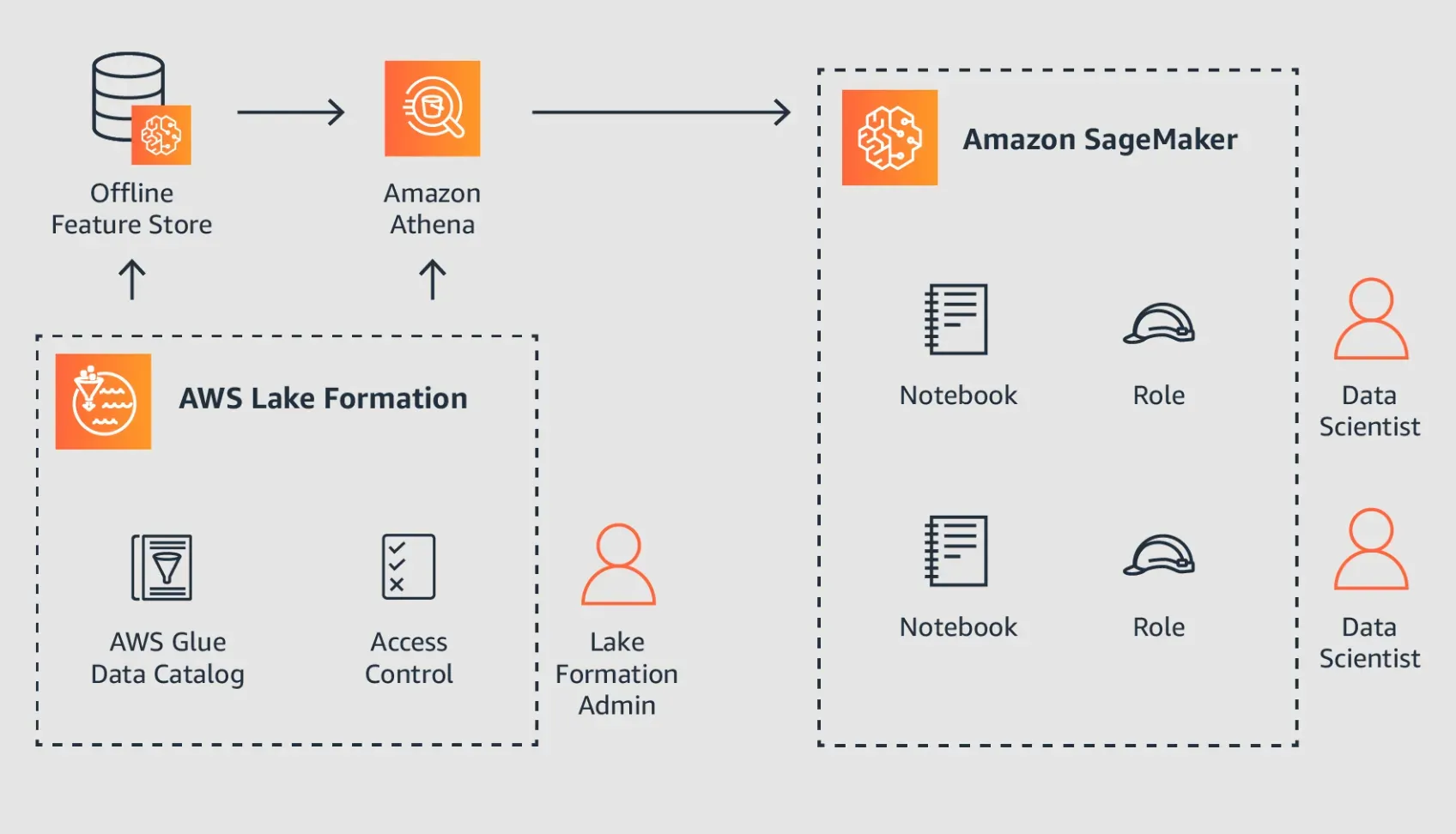What is Amazon SageMaker?
Amazon SageMaker is a cloud-based machine learning platform provided by Amazon Web Services (AWS), aimed at delivering end-to-end machine learning workflows, from data labeling to model deployment.
SageMaker Studio
SageMaker Studio is an Integrated Development Environment (IDE) for machine learning built into the SageMaker platform. It allows users to manage and navigate through data exploration, training, tuning, and deployment processes.
SageMaker Ground Truth
SageMaker Ground Truth is a data labeling service integrated with the platform, improving the efficiency of data annotation for supervised learning tasks.
SageMaker Autopilot
SageMaker Autopilot is an automated machine learning (AutoML) feature capable of building, training, and tuning machine learning models with minimal human interaction, automatically selecting the most appropriate algorithm and feature engineering techniques.
Why use Amazon SageMaker?
There are numerous reasons to use Amazon SageMaker, ranging from increased productivity to flexibility and scalability.
Reduced Model Development Time
SageMaker simplifies and streamlines the machine learning workflow, enabling developers and data scientists to focus on core tasks without worrying about infrastructure details.
Seamless Integration with AWS Ecosystem
Being part of the AWS suite of services offers SageMaker advantages like seamless scaling, integration with other AWS tools such as S3 for data storage, and easy access to required resources.
Flexible and Customizable
SageMaker provides built-in algorithms and pre-built models, but it also enables users to utilize custom and third-party algorithms or libraries.
Comprehensive Model Management
SageMaker allows model versioning and deployment in various environments (e.g., staging or production) with automated rollback options for faster and smoother iterations.
Where to use Amazon SageMaker?
Amazon SageMaker can be employed in numerous industries and use cases, some of which are highlighted below.

Sentiment Analysis
SageMaker can be used to train and deploy sentiment analysis models for applications such as marketing, e-commerce, social media monitoring, and customer feedback.
Fraud Detection
SageMaker helps in building models to identify fraudulent activities in various industries like finance, insurance, and telecommunication.
Predictive Maintenance
By leveraging SageMaker's capabilities, manufacturing companies can predict machine failures and devise preventive maintenance strategies.
Anomaly Detection
SageMaker enables users to create models that can detect unusual patterns in data, benefiting applications such as cybersecurity, quality control, and network monitoring.
When to use Amazon SageMaker?
Amazon SageMaker should be considered whenever organizations require an efficient and comprehensive machine learning platform to support their projects.
Small and Medium-Sized Enterprises
SMEs can utilize SageMaker's features and pre-built models to quickly implement machine learning applications without having to invest in significant infrastructure or resources.
Large Enterprises
SageMaker can scale to meet the needs of larger organizations, providing a customizable and powerful platform for various applications.
Research and Learning
Students, academics, researchers, and developers can use SageMaker to quickly experiment with machine learning techniques and better understand their performance in various contexts.
How to use Amazon SageMaker?

The following sections detail the essential steps involved in using Amazon SageMaker.
Access SageMaker Studio
SageMaker Studio is accessible through the AWS Management Console. It provides a user-friendly interface for managing machine learning workflows.
Prepare Data and Training Environment
Organize, clean, and preprocess data for training purposes. Set up the necessary infrastructure, such as data sources, annotations, and compute instances, for a smooth and efficient training process.
Train and Tune Models
Select a suitable algorithm, whether built-in, custom, or third-party, and train your machine learning model. Use SageMaker's tuning capabilities to optimize model hyperparameters.
Deploy Models
Deploy trained and optimized models to a deployment environment, such as an API or a web service, and monitor their performance.
Monitor Model Performance
Track deployed model performance in real-time using SageMaker's monitoring capabilities and make data-driven decisions to improve models.
Best Practices for Using Amazon SageMaker
Adopting best practices with Amazon SageMaker not only leads to more efficient use of the platform, but also, in many cases, it can guide the user towards an optimal output. Here are some of the best practices:
Use Built-in Algorithms When Applicable
Amazon SageMaker provides a range of pre-built and optimized machine learning algorithms suitable for numerous applications. When available and fitting the problem at hand, using these built-in algorithms can save time and computational resources, and yield satisfactory results.
Streamline Data Preprocessing with SageMaker Processing Jobs
SageMaker Processing Jobs allow you to run your data preprocessing, postprocessing and model evaluation workloads on fully managed infrastructure. By using these, you can readily transform your data at scale and free up your local resources.
Make use of Hyperparameter Tuning
Amazon SageMaker's automated hyperparameter tuning function can enable you to optimize your model training. Hyperparameter tuning systematically selects model parameters to yield improved results.
Enable Distributed Training
For large datasets or complex models, you can use SageMaker's distributed training capability. This can significantly decrease training times and help you take full advantage of the cloud's scalability.
Implement A/B Testing for Model Deployment
When deploying models, consider A/B testing to compare models’ effectiveness. This helps to ensure that you’re deploying the model that will provide the best possible predictions.
Continuously Monitor Model Performance
SageMaker offers Model Monitoring, which enables continuous evaluation of deployed models. Regular monitoring can provide alerts about anomalies or deterioration in model performance, allowing timely responses and revisions.
Challenges with Using Amazon SageMaker

Despite the extensive benefits offered by SageMaker, users might encounter certain challenges.
Steep Learning Curve
As a complex and wide-ranging platform, SageMaker may initially seem daunting, especially to users new to machine learning. It might require significant time and effort to become proficient in navigating and effectively utilizing the platform's features.
Managing Costs
As with any cloud service, costs can increase rapidly with extensive usage. Training large models or maintaining always-on endpoints can quickly drive up expenses. Therefore, managing costs on Amazon SageMaker can be challenging, especially for organizations new to AWS or cloud-based services.
Achieving Customization
While SageMaker does offer a degree of flexibility and the ability to use custom models, it might not provide the same level of granular control offered by building and training models locally. Users may need to make trade-offs between complexity, control, and convenience.
Examples of Amazon SageMaker in Action
To better illustrate its usage, here are some examples where Amazon SageMaker is used.
Improving Customer Service with SageMaker
Intuit, a financial software company, has used SageMaker to improve their customer service. By using SageMaker to develop, train, and deploy their machine learning models, they were able to predict customer needs and significantly improve customer service experiences.
Enhancing Medical Research with SageMaker
Celgene, a biotechnology company, utilized SageMaker to accelerate drug discovery and enhance medical research. They developed machine learning models capable of systematically analyzing cellular images to identify disease indicators faster and more accurately.
Streamlining Supply Chain with SageMaker
Konux, a startup in Munich, used SageMaker to augment their IIoT (Industrial Internet of Things) solution. Their AI models, built and deployed with SageMaker, significantly improved the prediction of rail asset maintenance needs, resulting in a more streamlined supply chain for rail freight companies.
Trends in Amazon SageMaker

Several recent trends are shaping the evolution of SageMaker.
Enhancements in AutoML
Improvements in SageMaker Autopilot, such as supporting more algorithms, data types, and use cases, enable users to fully explore the platform's automated capabilities.
Integration with Other AWS Services
Stronger integration with other AWS services creates added value for users by streamlining and simplifying machine learning deployment and monitoring.
Industry-Specific Applications
Growing adoption of Amazon SageMaker in diverse industries like healthcare, finance, and retail signifies its expanding applicability and versatility.
MLOps Support
Strengthening MLOps capabilities within SageMaker, such as the automation and monitoring of machine learning pipelines, helps organizations optimize their machine learning practices.
Shift towards Reinforcement Learning
Enhanced support for reinforcement learning in SageMaker allows organizations to build models for complex decision-making processes and dynamic environments.
Frequently Asked Questions (FAQs)
What is the Role of AWS SageMaker in Machine Learning?
SageMaker is a fully managed service that enables developers and data scientists to build, train, and deploy machine learning models quickly and at scale.
Can AWS SageMaker be Integrated with Other AWS Services?
Yes, SageMaker can be integrated with other AWS services like AWS Lambda, Amazon S3, or Amazon Athena for efficient data processing and model deployment.
What are SageMaker Notebooks?
SageMaker Notebooks offer a fully managed Jupyter notebook instance for flexible experimentation and quick prototyping in a familiar interactive environment.
Does AWS SageMaker Support Multiple Programming Languages?
Yes, SageMaker supports several languages including Python, R, and Julia, to name a few. This allows for versatile and inclusive model development.
How Secure is AWS SageMaker?
SageMaker provides several security and encryption features compliant with AWS's high security standards. This includes network isolation with VPC and encryption for data at rest or in transit.

